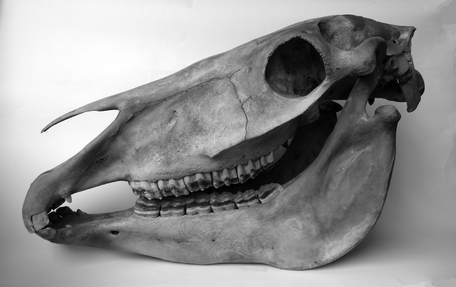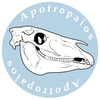Horse Skulls
 This is Herbert, my horse skull.
This is Herbert, my horse skull.
Horse skulls are an interesting find. Unlike witch-bottles, they are found in quite large numbers in Ireland, Wales and England. In Scotland there have been some examples of deer bones being concealed but so far none of horse skulls - although I would be surprised if there were none there.
In England several examples occur in the south east and twenty-four were found screwed to the underside of the floor at a pub called the Portway at Staunton-on-Wye in Herefordshire. There is a church at Ellsdon in Northumberland which contains three skulls in its bell turret. In Cambridgeshire several houses contain horse bones within the structure of the walls and in Wales there are over forty recorded examples. These skulls are most usually found within the structure of fireplaces or under the floor although they have been found in walls.
Like cats, horses have been credited with the ability to see things which we generally can’t. It seems likely that this practice is for the same reason as cats. The position of the ones in the bell turret do firmly suggest a link with the function of bells, which was originally to frighten evil spirits away before the congregation began to assemble for church. This seems to be a very old and very widespread tradition.
Recommended reading:
Brian Hoggard, Magical House Protection - The Archaeology of Counter-Witchcraft, Berghahn, 2019.
Brian Hoggard, 'Concealed Animals', in Ronald Hutton, The Physical Evidence for Ritual Acts, Sorcery and Witchcraft in Christian Britain, 2015, Palgrave, pp106-117.
Brian Hoggard, 'The archaeology of counter-witchcraft and popular magic', in Owen Davies & Willem de Blecourt, Beyond the Witch-Trials, 2004, Manchester University Press, pp167-186.
Ralph Merrifield, The Archaeology of Ritual and Magic, 1987, Batsford, London.
In England several examples occur in the south east and twenty-four were found screwed to the underside of the floor at a pub called the Portway at Staunton-on-Wye in Herefordshire. There is a church at Ellsdon in Northumberland which contains three skulls in its bell turret. In Cambridgeshire several houses contain horse bones within the structure of the walls and in Wales there are over forty recorded examples. These skulls are most usually found within the structure of fireplaces or under the floor although they have been found in walls.
Like cats, horses have been credited with the ability to see things which we generally can’t. It seems likely that this practice is for the same reason as cats. The position of the ones in the bell turret do firmly suggest a link with the function of bells, which was originally to frighten evil spirits away before the congregation began to assemble for church. This seems to be a very old and very widespread tradition.
Recommended reading:
Brian Hoggard, Magical House Protection - The Archaeology of Counter-Witchcraft, Berghahn, 2019.
Brian Hoggard, 'Concealed Animals', in Ronald Hutton, The Physical Evidence for Ritual Acts, Sorcery and Witchcraft in Christian Britain, 2015, Palgrave, pp106-117.
Brian Hoggard, 'The archaeology of counter-witchcraft and popular magic', in Owen Davies & Willem de Blecourt, Beyond the Witch-Trials, 2004, Manchester University Press, pp167-186.
Ralph Merrifield, The Archaeology of Ritual and Magic, 1987, Batsford, London.
